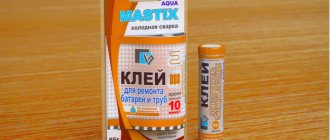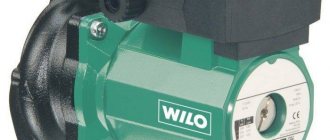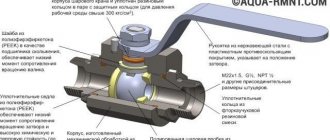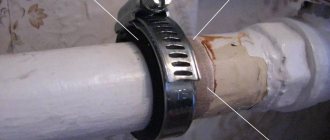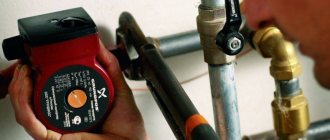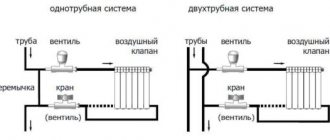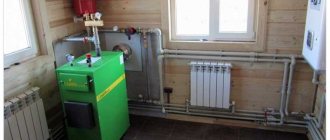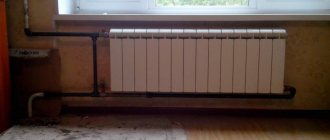The battery can be returned to work after one day.
Just ten years ago, a cast iron battery was the absolute favorite when it came to constructing a heating system. Cast iron radiators were installed both in apartment buildings and in private ones. These products have a fairly long service life (20 years or more), so their breakdown usually takes a person by surprise. What to do if a cast iron battery leaks? Is it really impossible to cope with such a nuisance on your own?
How and with what to seal a leak in a heating battery so as not to spend money on a new radiator
However, even such a simple device can fail.
As a rule, such cases are unexpected for the owners. Sometimes the situation can only be resolved by urgently calling an emergency team. Fortunately, owners are often able to cope with the problem on their own. You just need to know how to repair a leak in a heating battery so that the equipment can last for quite a long time. However, let's initially decide when it is still necessary to call the emergency service, and not try to fix the situation ourselves. If you live in a private house, then at any time you can turn off the heating system and calmly fix the leak or replace the radiator, so such cases need not be considered. But if you live in an apartment connected to central heating, then everything depends on how the radiators are connected. There are two options:
- with shut-off valves. If there is a valve on the pipe to which the battery is connected, then with its help you can shut off the coolant flow. But at the height of the heating season, this should be approached with caution. In many cases, closing the valve will stop the flow of coolant to the neighbors in the riser - this depends on the wiring diagram of the heating system. In such situations, you can close the valve only if there is a bypass. This is a piece of pipe that forms a bypass path for the coolant current. This way, the liquid can circulate freely further along the route while you are repairing the radiator;
- without shut-off valves. If there is no way to shut off the coolant flow, then if a 100% leak occurs, it is necessary to call an emergency team. Firstly, in this case, the liquid supply can only be shut off using a valve on the common riser - residents of an apartment building, as a rule, do not have access to it. Secondly, this needs to be done urgently, even in a situation where the leak is not that strong - for example, water drips in a thin stream. Remember that this can suddenly turn into a real fountain, with almost boiling water running in the pipes. Workers of any emergency team can tell you about cases where delay led to severe flooding of the apartment, which, given the temperature of the liquid, is very difficult to eliminate. And even before flooding, water “rushing” from the radiator can leave serious burns on people nearby. In general, you shouldn’t delay - at any time of the day or night, if you notice a leak, immediately call the emergency services.
In the second situation, while you are waiting for the emergency team to arrive, you can make things a little easier. If the leak is strong—the coolant is literally splashing out of the battery—then throw a blanket over the area. You won’t save your apartment from flooding, but at least you will protect your family members from burns.
If the leak is small, the liquid runs in a thin stream, then you can get by with “little bleeding.” Wrap the battery in the area of the leak with a cloth, such as a towel. Dip the ends of the tourniquet into the basin. This way you will direct the coolant into the container and not onto the floor. You can also try to completely eliminate such a leak. But let's talk about this in more detail.
FAQ
Homeowners have the same questions about how to solve such problems.
The following are often of interest:
- where to go if the battery leaks;
- what to do if it is not possible to turn off the water;
- who is to blame if the neighbors are flooded?
Where to go if the heating battery is leaking?
It makes sense for owners of apartments in multi-storey buildings to call a plumber by contacting the housing and communal services service, HOA or management company. Emergency telephone numbers should be posted in entrances. There is an option to call an employee of a private company that provides such services. In a private home you will have to deal with the problem yourself.
How to eliminate a leaking heating battery without shutting off the water?
If the cause of the leak is a crack in the pipe, it can be wrapped in rubber and tightened from above with any clamp or wire. If it is a small sink, then you need to take a metal screw with a rubber washer and screw it in with a screwdriver. These measures are only effective at low pressure in the circuit. After the manipulation, you need to turn on the pump and make sure that the repaired area can withstand the water pressure in the system.
When radiators leak in an inaccessible place and the leak is small, you should add mustard to the expansion tank. Place a container under the dripping unit and increase the temperature of the water in the system. Mustard powder, like a liquid sealant, reaches the leak and closes it. There are ready-made liquid sealants on sale just for such cases. Add them to the system, and all minor leaks will stop bothering you.
Who is to blame if a heating pipe bursts and floods the neighbors?
The owner of the apartment panics when hot water breaks out and rushes out in all directions. By the time you reach the tap, the entire floor will flood. And the floor of the room serves as a ceiling for the neighbors below. You can localize a leak by throwing any thick rag over the break site. The water will flow down it, where you place the basin. This will give time to turn off the water and turn off the pump, if there is one.
When your apartment has centralized heating, the algorithm of actions is different.
A breakdown in the heating system can happen at any time of the year. The management company must conduct technical tests of pipes before the heating season. To do this, they are tested by applying high pressure. Residents should be warned about this. If a breakthrough occurred as a result of such a procedure, then the actions are as follows:
- If you are at home at the time of the breakthrough, then turn off the water.
- Call the management company by phone and report the incident.
- Capture on photo or video:
- location of damage (breakthrough);
- consequences of flooding: damaged property in your apartment;
- damaged property and belongings of neighbors.
- Achieve the drawing up of an act.
Sometimes citizens think that it is better to install air conditioners and turn them on for heating than to compensate their neighbors for damage. Air conditioners are not designed to operate in temperatures below -4°C. The condensate in the drain pipe freezes, the external unit suffers, and the device may fail. It is best, if possible, to install individual heating. In this case, it is necessary to replace metal pipes with plastic ones and install aluminum radiators.
Types and causes of leaks
As a rule, a leak occurs in the off-season, when the heating is turned off, as the metal cools down, the metal narrows and water begins to seep into the threaded joints.
If the heating radiator is leaking, then it is necessary to determine the cause and location of the breakdown. Each plumbing point consists of a heating radiator and an adjacent pipeline. The connections of these elements can be disrupted under the influence of the following factors:
- Long service life as a cause of wear;
- Poor installation of the heating system;
- Mechanical impact, brute force;
- Corroded metal.
Depending on which elements the coolant leak occurred between, the following types of failures are distinguished:
- Violations of the seal between the riser pipes and the battery pipes;
- Partial destruction of the main pipes that connect the radiator and the riser;
- Leakage in the area of intersection connections;
- Formation of a fistula or crack in one of the radiator sections.
For each of these cases there is a different way to eliminate the accident. If the battery is dripping, don’t rush to find out what to cover it with. You may not need to smear at all.
Dripping between the nozzle and the main pipe
A leak at the junction is often the result of improper installation, or a domestic situation where the batteries were used as a support for heavy objects or residents. To complete the repair you will need:
- Car clamp or wire;
- A piece of thin and flexible rubber.
Procedure:
- Cut strips of rubber measuring 5x35 cm or use a rubber bandage from a pharmacy;
- Wrap the strip around the damaged area;
- Secure the rubber with wire or a zip tie.
In this situation, a clamp will be a more suitable option, since it is inexpensive and fixes the damaged joint reliably, evenly, without the risk of overtightening.
Main pipe leaks
There are always two such pipes. One for supplying coolant to the radiator, and the second for discharging cooled water. They are made of steel and tend to corrode and wear out from the inside over time for two reasons:
- Filling with water in the off-season;
- Impurities in water supplied through heating mains.
Most often, the question of what to do if the heating radiator is leaking arises at the height of the heating season. In the event of an accident, a cement-plaster bandage is used on a straight section of pipe. To prepare it you will need:
- Non-sterile bandage;
- Cement;
- Alabaster;
- Container for mixing the mixture.
Important! Alabaster is required when there is no way to turn off the water. It is applied as the first layer, as it dries faster than cement and adds reliability to the dressing.
- Mix cement with water to the consistency of liquid sour cream;
- Prepare strips 25-30 cm long;
- Soak the bandage strips in the mixture;
- Wrap them around the damaged area layer by layer;
- Continue until a tight bandage is obtained.
If a stream of water gushes like a fountain
If a fistula has formed and water flows in a stream, then you can hammer in a wooden wedge before the mechanics arrive. The wood gets wet and holds water well.
What to do from the very beginning
If the damage is serious enough, you must immediately call an emergency team. In any case, professional plumbers will at least have all the necessary tools and materials to localize the accident.
If boiling water is pouring out of the battery in all directions, then it is better to throw something like a blanket over it. This will not eliminate the leak, but it will allow you to approach the heating device without the risk of thermal injury.
Throwing a blanket over the radiator
Shutting off the water
Remember, is it possible to shut off the water supply to the heating system in the apartment? If the water can be turned off with a tap or valve, then this makes it possible to at least save property.
Typically, the valve for shutting off the coolant into the heating system is located on the main pipe near the entrance of this pipe to the basement.
Typical view of a tap on a heating system pipe
If the leak is not very strong, you can fix it yourself.
Fixing a leak using a self-tapping bolt
If a leak has formed on a cast iron radiator, it can be eliminated using a self-tapping bolt, which is fixed in a hole on the battery section or on a section of heating pipe.
Repairing a minor leak with a cement-plaster cast
Before fixing a leak in a heating radiator, you need to prepare.
In order to “defeat” a minor leak, you will need the following materials and tools:
- ordinary medical bandage;
- cement;
- plaster (alabaster);
- salt;
- container with water.
The leak is eliminated by applying a special bandage to the damaged area.
If you manage to turn off the water, then the next steps are as follows:
- Cement is diluted in a container with water to the consistency of thin sour cream;
- The bandage is cut into strips about 25-30 cm in length;
- The bandage strips are thoroughly soaked in the cement mixture;
- Impregnated strips are wrapped around the damaged area;
- The process is repeated until a strong bandage is formed.
Repairing a leak with a cement bandage
If a leak has formed at the threaded connection, then regular table salt should be used as follows:
- Soak strips of bandage or cloth in water;
- Roll the soaked strips generously in salt;
- Wrap the leak area.
Salt, dissolving in water, cokes the gap. A cement dressing should be applied on top as described in the instructions above.
Leak elimination scheme
Fixing a leak using a clamp or rubber
If the location of the damage is at the connection between the radiator and the main pipe, then it is possible to stop the leak for some time if you use a rubber band and wire (a car clamp). A piece of rubber is wrapped around the damaged area and secured with wire.
Pieces of rubber can be cut from a bicycle inner tube. To do this, you need to prepare strips 4-5 cm wide and 30-35 cm long.
If there is a clamp, the leak can be completely stopped for some time. Therefore, it is useful to have a couple of clamps on hand at home just in case, especially since their price is low.
Photo of the applied clamp
Repairing leaks with moisture-resistant glue
If the battery leaks at the junction between the sections, then the problem can be eliminated using a cloth soaked in moisture-resistant and heat-resistant glue. After the glue dries, the leak will at least be reliably sealed.
A two-component epoxy adhesive is suitable for eliminating leaks.
Repairing leaks with a sealed seal
For minor damage, you can use a special polymer or powder-based sealant. Such compounds are sold in hardware stores, and they are intended specifically for such repairs.
Upon contact with air, the material polymerizes. When cured, it creates a strong filling that will allow time for more significant repairs.
What problems occur most often and why?
- As you know, cast iron batteries are very heavy, so they should be mounted on special fasteners. If a minor mistake is made during installation, the radiators may sag and tilt under their own weight. A misalignment of just a few millimeters already negatively affects the efficiency of the device. If this problem is not corrected, then after some time corrosion will begin to form in the place where the coolant does not reach. Over time, cast iron becomes thinner under the influence of corrosive processes, which leads to the formation of a fistula. It is through this that water flows.
- In apartment buildings where a centralized heating system operates, powerful water hammers very often occur. As a result, leakage occurs at the joints of sections.
- Due to the roughness of the inner surface of cast iron batteries, a lot of different debris accumulates on it. If we take into account that the coolant is rarely free of impurities, then over the years of operation a sediment of rust, pieces of metal and other foreign impurities accumulates inside the batteries. The channels become clogged and can no longer pass water fully. In this case, the risk of battery breakdown will increase. Increased acidity of the coolant also negatively affects cast iron.
- The weak points in batteries are gaskets and nipple threads. This is where leaks most often occur.
Usually, before a leak occurs, certain signs are observed: the room becomes colder, plaque appears on the radiator, and rusty spots appear on the surface of the device. You shouldn’t be inactive at the first suspicion of a leak - you need to quickly fix the problem without waiting for an accident. If puddles of water are already appearing under the battery, or the level of humidity in the room has increased, then it is necessary to urgently repair the product.
The best time to start repairing heating radiators is from late spring to early autumn. The heating season is over, and you can calmly, thoughtfully and without undue haste, inspect the sections for damage, and carry out their full restoration. However, unfortunately, troubles always come when you least expect them, and according to the law of global meanness, the batteries burst in the middle of the heating season.
It’s good if the residents were at home when the heating battery leaked and responded to the problem in time, preventing the neighbors below from flooding. If this trouble happened to you in winter, then be prepared to live in not very comfortable conditions for some time. Also, do not forget to warn your neighbors that you have heating radiators that you plan to repair.
Types of radiators by material
Let's look at a few of the most popular types of batteries and look at their features.
Bimetallic radiators
This type of heating device has a beautiful appearance and is inert to corrosion. Able to provide excellent heat transfer. Repairing this type of radiator is quite affordable on your own, but not so common, since they are distinguished by quite good reliability.
Steel batteries
This type of radiator, like the previous one, is characterized by excellent heat transfer and low weight, but is not nearly as reliable. And most of the cases when heating radiator repairs are required are associated with these heating devices. This type of radiator should not be installed in houses where the heat supply is centralized, since their short service life and high susceptibility to the negative effects of corrosion will not allow them to last long.
Aluminum
This type of heating device is very good to use, has excellent heat dissipation, weighs little and looks beautiful. However, this type of device is very picky about water quality, and can be damaged if there are strong pressure surges. If too many chemical impurities have accumulated in the heating fluid, repairing the aluminum heating radiator will be impossible, so they can only be installed locally. Where the quality of the coolant is constantly monitored.
Cast iron products
One of the most reliable and well-known types of heating batteries. They are characterized by high heat capacity, reliability and excellent strength. They are not afraid of corrosion, and are not at all picky about the quality of the coolant. So you are unlikely to need to wash cast iron batteries yourself more than once every ten years. Due to the fact that, despite all their advantages, these heating devices weigh a lot, it is quite difficult to install and maintain them, so replacing heating batteries in an apartment with your own hands, especially if the radiators are made of cast iron, is only possible if you are completely confident in your abilities and knowledge. In addition, the repair of cast iron batteries is a fairly common occurrence, since their intersection gaskets are subject to fairly rapid wear, as a result of which they leak relatively often.
Eliminating leaks at the joints of radiator sections
Sometimes it is quite difficult to determine the location of a radiator leak, as water begins to curl over the entire surface of the battery. To find a place where the material could not withstand the pressure of water, you should completely wipe the surface of all sections and carefully inspect them. When you see where water appears, you should turn off the shut-off valves so that there is no liquid left in the radiator. After this, use the Mayevsky tap to reduce the pressure.
You should begin eliminating the leak only after water has stopped dripping from the rusted area. To eliminate intersectional leaks in the radiator, cold welding can be used. The most common type is epoxy mastic with various additives.
But first you need to clean the junction of the sections. The first step is to clean the surface of paint, and you can use a steel cable to remove rust and dirt. The reliability of the patch made will depend on the quality of cleaning of the joint.
After purchasing a specific product, you should carefully read the instructions, since some types of such compounds are not intended for a certain type of pipe. Usually, to create the desired composition, it is necessary to combine several components and apply it to the damaged area using a syringe. The mastic dries in about 3 hours, after which the battery can be used again. One-component compounds are also often used, which must be kneaded before applying to the battery.
Security measures
Carrying out welding work at home requires careful and precise adherence to safety precautions. The most important points:
- the room in which welding work is carried out must be illuminated and ventilated ;
- It is mandatory to use means for grounding ;
- Cast iron does not respond well to rapid cooling, so its surface must be protected from moisture ;
- personal protective equipment when working .
Battery input
One of the problem areas where leaks often occur is the junction of the battery with the pipe from the riser. Typically, the appearance of such a leak is not caused by damage to the area, but by a leaky seal on the thread. To eliminate such a leak in the heating battery, it is necessary to close the riser as quickly as possible. After this, the pressure in the battery is reduced using a Mayevsky tap or another method. Using an adjustable wrench, unscrew the nut or coupling that makes the connection. Next, the rust at the leak site is cleaned, and the old sealant in the form of flax fiber is removed.
In case of such leak repair work, it is advisable to acquire a new nut or coupling. If they have been used for a long time and have not been changed, then they can easily burst while eliminating the leak. When the threads on a pipe are damaged, you can use a die to fix them. Several turns of tow are wound around the joint and it is covered with Unipak paste. After these steps, the assembly is reassembled and the supply tap is gradually opened. This will allow you to timely determine whether the leak has been completely eliminated.
Welding Application
If you have certain skills and a welding machine, you can simply weld the leak. This is the best way to solve the problem, but it is not suitable for all radiators - only for steel appliances.
In case of serious damage, it is necessary to call an emergency team - experienced plumbers will be able to quickly solve the problem. If the leak is small, then it can be eliminated using improvised means. But you need to remember that any method of eliminating a leak will only help temporarily restore the operation of the heating device, so it is recommended to change it in the near future.
One way to fix a battery leak is shown in the video:
The main causes of malfunctions of cast iron radiators
Cast iron is highly durable, the service life of heating products is 25–30 years , under optimal conditions - 50 years or longer.
But thick-walled cast iron batteries have vulnerabilities: most often radiators leak between sections, at connections with pipes, and sometimes fistulas and cracks appear on the cast iron itself.
The main reasons why repairs have to be carried out:
- Heavy weight. Depending on the type and manufacturer, the weight of one cast iron section is 4.5–7.1 kg, the filling volume is 1–4 liters , the standard set consists of 4–10 elements. In case of unskilled installation and incorrect calculation of the number of brackets, the radiator becomes skewed. As a result, the joining elements suffer and metal fatigue occurs. In places where there is no coolant, corrosion appears, then a fistula.
- Instability to water hammer and high pressure. When an obstacle is abruptly removed, the liquid acquires enormous speed and rushes to the area of lowest pressure. The power of the water hammer in the heating circuit exceeds the force of a hammer blow. A sudden change in pressure or its high levels threaten depressurization of the heating system - leaks most often occur at the joints where parts of the radiator are connected.
- Dirt and trash. Elements of domestic cast iron batteries are produced by casting. The technology is such that the surface remains rough, which is excluded in imported analogues.
Due to the granularity, particles of rust and suspension that fill the coolant settle on the walls. Gradually, the channels become clogged and cannot withstand the pressure of water - the battery may burst from pressure or water hammer. To prevent repairs, regular flushing of the system is required.
Photo 1. The elements of the cast iron battery are clogged with rust and debris; because of this, the radiator cannot cope with the water pressure.
- Wear of intersection gaskets. The strength of collapsible joints is always inferior to monolithic structures. Intersectional gaskets and threaded battery nipples wear out faster than cast iron and are more susceptible to temperature and pressure. To avoid leaks and emergency repairs, do not forget about prevention: after the heating season, check the connections and change the gaskets.
Tools and materials for eliminating defects with your own hands
Minor repairs of cast iron radiators are possible without the involvement of master plumbers , with your own hands. Depending on the method of restoration work, you will need:
- metal cable or sandpaper - to clean the defect area ;
- for repairing section joints: clamp - a fastener consisting of two rubberized plates from the inside, connected by bolts;
- to eliminate fistulas: cold welding for radiators - a plastic mass intended for fixing metal parts without thermal heating;
- degreasing solvent: gasoline, acetone, white spirit and others;
- one of the sealants: iron powder, polymer, cold welding, epoxy resin;
- bandage or strips of fabric;
- a wrench to match the size of the clamp fasteners, pliers;
- rags, oilcloth, container for collecting water.
Attention! For emergency repairs, instead of a clamp a piece of thin rubber cut from a car inner tube or an elastic rubber bandage and wire for fixation are used.
To wash cast iron batteries, prepare an adjustable pipe wrench, solutions of 10% caustic soda , citric acid ( 50–60 g per liter ) or a special liquid for heat exchangers.
Photo 2. Preparation of a solution for flushing a cast iron radiator; soda and citric acid are added to it.
Repair and cleaning in case of battery leakage
Actions to eliminate the defect depend on its location and the severity of the failure. In all cases, repairs begin with preparing the workplace.
Attention! If the leak is significant, call an emergency team. Attempting to tighten a crack under pressure with a clamp is dangerous to health, as it can lead to rupture of the radiator.
Sequence of work when repairing section joints:
If rubber is used instead of a clamp to repair the joint of cast iron radiators, wrap it around the leak area and tighten it with wire using pliers.
Reference! A clamp without prior application of sealant is used to quickly eliminate minor leaks. The rubberized base ensures tight connections.
If the fistula has formed on a cast iron surface, apply cold welding using the indentation method to the cleaned and degreased area to repair it. A non-standard solution to the problem is to drive a wooden plug into the hole or screw in a self-tapping screw and cover the top with sealant.
Sequence of work
Depending on how serious the breakdown is, the steps to fix it depend. So, if the leak is small, then you can do without disconnecting the battery from the circuit, and for repairs you will need:
Place a container under the breakdown site in case of a breakthrough or an oilcloth with rags to collect water.
The area of the rupture or crack must be cleaned down to the base using a cable or sandpaper. It is necessary not only to remove a layer of paint, but to expose the metal itself. Degrease the prepared area with some solvent. If special glue or epoxy resin is used to repair the damage, then strips of thick fabric or bandages will be required
Apply the product to them and wrap several layers around the tear site. If cold welding is used, fabric is not needed. A clamp is put on and screwed onto the area captured by the sealant, but it is important to ensure that its clamps are on the opposite side of the leak. For example, a crack has formed on the inside of the radiator, which means the clamps will be on the outside, and vice versa. If the breakdown is serious and hot water is gushing out of the battery, then you need to call an emergency team, and not try to stop the leak yourself without the necessary tools.
Even the highest quality repairs do not guarantee long service life of the device. Restored cast iron radiators will still have to be replaced, and the sooner this is done, the safer it will be in the apartment.
First signs of breakdown
There is a list of “symptoms” indicating that not everything is in order with the heating batteries. These include:
- the rooms became cool. Try asking your neighbors and find out if their apartment is warm. If they are doing well, then you have a problem. The reason may be contamination of the equipment, misalignment or the presence of fistulas. In the first case, it is enough to wash the batteries; in the second, fix or replace the brackets and check the correct installation with a construction ruler. In the third - radiator repair;
- If a strange coating appears on the surface of the battery, then the reason is the wear of the gaskets. It is necessary to turn off the system, remove the batteries and install new ones;
- The leak is immediately visible. If it is small, then you can use a clamp or cold welding, otherwise you will have to change the equipment.
Even small, barely noticeable defects can turn into a large and serious problem if they are not corrected in time. Temporary clamps and patches will not help. Only professional specialists will make diagnostics, determine the reliability and density of the heating circuit and its parts, and also carry out qualified repairs.
